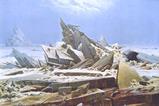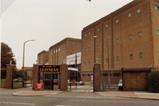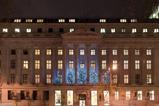A handsome, red brick, Italianate building in Exhibition Road, South Kensington is currently the Henry Cole wing of the Victoria and Albert Museum and a home to museum offices and archives.
When it was built in 1872 it was intended for the School of Naval Architecture but, on completion, the naval draughtsmen were banished to Greenwich and replaced by the Science Schools, later called the Normal School of Science, an amalgamation of the Royal College of Chemistry and the School of Mines. The Professor of Biology at the School was Thomas Henry Huxley, famously known as ‘Darwin’s bulldog’ for his vigorous advocacy of the theory of evolution through natural selection. Huxley was an inspiring and innovative teacher and, created modern, well-lit and -equipped biology laboratories on the top floor where practical classes involved extensive use of the microscope as a tool to examine the structural features of yeast cells, as well as larger organisms.
When Herbert George (H.G.) Wells enrolled in the School in 1884, Huxley was in his last year there. Wells had won a scholarship after unhappy periods as an apprentice draper and a student teacher and was destined to become a major public figure, best known today as a founding father of science fiction, author of works such as The War of the Worlds, The Invisible Man and The Time Machine.
Wells was born in 1866 in relatively humble circumstances in Bromley, Kent, now part of Greater London. But even then, the influence of the capital must have made itself felt since Wells writes of growing up with a cockney accent and an online article on phonetics I have seen describes his recorded voice as ‘halfway to Estuary English’.
His academic career at the Normal School was chequered. He excelled in biology and was inspired by Huxley, describing his first year as ‘the most educational year’ of his entire life, but his later studies in physics and geology were hindered by a combination of uninspired teaching and the twin distractions of his political activities (he was an idiosyncratic socialist) and occasional writing for magazines such as the Science Schools Journal. Some sense of his time at the School can be gained from the partly autobiographical Love and Mr Lewisham and the short story A Slip Under the Microscope. He eventually graduated with first class honours in zoology and second class honours in geology in 1890, the year the Normal School became the Royal School of Science (it was ultimately absorbed into Imperial College).
To secure an income, Wells took a teaching post while pursuing his dream of a writing career. In 1893 he published his first book, Textbook of Biology. Elementary biology was required for all aspirants to the London BSc and also, somewhat reassuringly, for those hoping to embark on a medical degree. It had, in his words, ‘long been regarded as a difficult subject’ and there were no textbooks ‘that precisely covered the peculiar mental habits of the university examiners’, a sentiment sometimes echoed by students today.
He would also employ his knowledge of biology (and microbiology) in fiction. Some will remember an unnamed pathogen jumping the species barrier to bring about the demise of the Martian invaders in The War of the Worlds. Microbiology can also claim the crown for being the subject of the very first piece of fiction published under his name. This took the form of a short story entitled The Stolen Bacillus, published in the Pall Mall Budget in June 1894.
The story itself is rather insubstantial, but is a very early allusion to something of much more recent concern: bioterrorism. It was inspired, in part, by a wave of anarchist terrorist incidents across Europe, in particular a bomb attack on the French Chamber of Deputies in Paris in 1893 by Ravachol Vaillant, who is mentioned in the text. A bacteriologist is showing slides and cultures to a visitor who takes a particular morbid interest in their pathogenicity. Prompted by his questioning, the bacteriologist shows the visitor what he claims is a viable culture of V. cholerae: ‘mysterious untraceable death, death swift and terrible, death full of pain and indignity’ as his visitor lugubriously observes. After the visitor has left, the bacteriologist discovers the culture is missing and rushes out in pursuit. His wife sees him leave precipitately without his hat, an affront to Victorian decency, and is compelled to follow. There ensues a hectic three-cab chase across London.
With his pursuers closing in, the anarchist alights near Waterloo Bridge but in the process breaks the culture tube. Unable to fulfil his original aim of infecting the water supplies, he drinks what remains in the broken vial. Confronted by the bacteriologist, still hatless and wearing a velveteen jacket and one carpet slipper (a look still favoured among some senior microbiologists today), he declares ‘Vive l’Anarchie! You are too late, my friend. I have drunk it. The cholera is abroad!’ With that he waves a dramatic farewell and strides off towards the bridge carefully jostling as many people as he can, with a view to spreading the infection. The bacteriologist’s wife, Minnie, the only character in the story given a name, then arrives bearing shoes, overcoat and a hat for her husband. Restored to decency, the bacteriologist confesses that his visitor’s interest had stroked his vanity and that since he did not have a culture of V. cholerae to show, he had substituted one of bacteria thought to be responsible for the blue colouration of certain monkeys. There, rather limply, the story ends. What happened next is left for the reader to imagine – perhaps the anarchist in his dingy lodgings, anxiously performing contortions before the mirror, monitoring the progress of unwanted Prussian Blue patches and aquamarine eruptions.












No comments yet